Related Research Articles
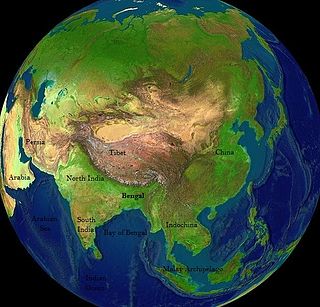
Bengal is a historical geographical, ethnolinguistic and cultural term referring to the eastern part of the Indian subcontinent at the apex of the Bay of Bengal. The region of Bengal proper is divided between modern-day Bangladesh and the Indian state of West Bengal. The administrative jurisdiction of Bengal historically extended beyond the territory of Bengal proper. Bengal ceased to be a single unit after the partition of India in 1947.

Muslim period in the Indian subcontinent is conventionally said to start in 712, after the conquest of Sindh and Multan by the Umayyad caliphate. It began in the Indian subcontinent in the course of a gradual conquest. The perfunctory rule by the Ghaznavids in Punjab was folllowed by Ghurids, and Sultan Muhammad of Ghor (r.1173–1206) is generally credited with laying the foundation of Muslim rule in Northern India.
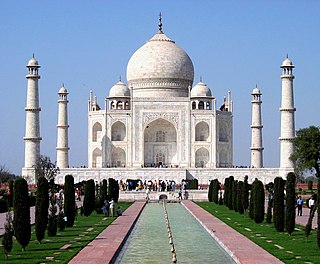
Indo-Persian culture refers to a cultural synthesis present in India. It is characterised by the absorption or integration of Persian aspects into the various cultures of modern-day republic of India. The earliest introduction of Persian influence and culture to the subcontinent was by various Muslim Turko-Persian rulers, such as the 11th-century Sultan Mahmud Ghaznavi, rapidly pushed for the heavy Persianization of conquered territories in northwestern India, where Islamic influence was also firmly established. This socio-cultural synthesis arose steadily through the Delhi Sultanate from the 13th to 16th centuries, and the Mughal Empire from then onwards until the 19th century. Various Muslim dynasties of Turkic, local Indian and Afghan origin patronized the Persian language and contributed to the development of a Persian culture in India. The Delhi Sultanate developed their own cultural and political identity which built upon Persian and Indic languages, literature and arts, which formed the basis of an Indo-Muslim civilization.
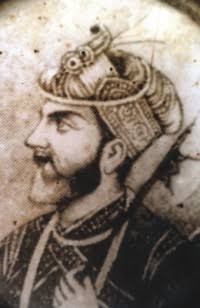
Isa Khan was the Bengali Muslim leader of the 16th-century Baro-Bhuiyan chieftains of Bengal and a zamindar of Khizrpur. During his reign, he successfully unified the chieftains of Bengal and resisted the Mughal invasion of Bengal. It was only after his death that the region fell totally under Mughal control. He remains an iconic figure throughout Bangladesh as a symbol of his rebellious spirit and unity.

Sonargaon is a historic city in central Bangladesh. It corresponds to the Sonargaon Upazila of Narayanganj District in Dhaka Division.

The history of Bengal is intertwined with the history of the broader Indian subcontinent and the surrounding regions of South Asia and Southeast Asia. It includes modern-day Bangladesh and the Indian states of West Bengal, Tripura and Assam's Karimganj district, located in the eastern part of the Indian subcontinent, at the apex of the Bay of Bengal and dominated by the fertile Ganges delta. The region was known to the ancient Greeks and Romans as Gangaridai, a powerful kingdom whose war elephant forces led the withdrawal of Alexander the Great from India. Some historians have identified Gangaridai with other parts of India. The Ganges and the Brahmaputra rivers act as a geographic marker of the region, but also connects the region to the broader Indian subcontinent. Bengal, at times, has played an important role in the history of the Indian subcontinent.
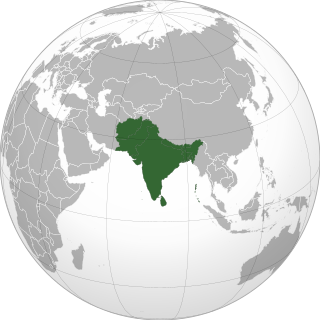
The Baro-Bhuyans were confederacies of soldier-landowners in Assam and Bengal in the late Middle Ages and the early modern period. The confederacies consisted of loosely independent entities, each led by a warrior chief or a landlord (zamindars). The tradition of Baro-Bhuyan is peculiar to both Assam and Bengal and differ from the tradition of Bhuihar of Uttar Pradesh and Bihar—in Assam this phenomenon came into prominence in the 13th century when they resisted the invasion of Ghiyasuddin Iwaj Shah and in Bengal when they resisted Mughal rule in the 16th century.

Sulaiman Khan Karrani was a Sultan of Bengal. He ascended to the throne after the death of his brother Taj Khan Karrani. According to the Riyaz-us-Salatin, he shifted the seat of government from Gaur to Tanda.

The Bengal Sultanate was a Sunni Muslim empire based in Bengal for much of the 14th, 15th and 16th centuries. It was the dominant power of the Ganges–Brahmaputra Delta, with a network of mint towns spread across the region. The Bengal Sultanate had a circle of vassal states, including Odisha in the southwest, Arakan in the southeast, and Tripura in the east. Its raids and conquests reached Nepal in the north, Assam in the east, and Jaunpur and Varanasi in the west. The Bengal Sultanate controlled large parts of the north, east and northeast South Asia during its five dynastic periods, reaching its peak under Hussain Shahi dynasty. It was reputed as a thriving trading nation and one of Asia's strongest states. Its decline began with an interregnum by the Suri Empire, followed by Mughal conquest and disintegration into petty kingdoms.

The Mughal Empire was an early-modern empire that controlled much of South Asia between the 16th and 19th centuries. For some two hundred years, the empire stretched from the outer fringes of the Indus river basin in the west, northern Afghanistan in the northwest, and Kashmir in the north, to the highlands of present-day Assam and Bangladesh in the east, and the uplands of the Deccan Plateau in South India.

The Zamindars of Bengal were zamindars of the Bengal region of the Indian subcontinent. They governed an ancient system of land ownership.

The Bengal Subah, also referred to as Mughal Bengal, was the largest subdivision of the Mughal Empire encompassing much of the Bengal region, which includes modern Bangladesh and the Indian state of West Bengal, Indian state of Bihar, Jharkhand, Odisha between the 16th and 18th centuries. The state was established following the dissolution of the Bengal Sultanate, a major trading nation in the world, when the region was absorbed into one of the gunpowder empires. Bengal was the wealthiest region in the Indian subcontinent, due to their thriving merchants, Seth's, Bankers and traders and its proto-industrial economy showed signs of driving an Industrial revolution.
The Karrani dynasty was founded in 1564 by Taj Khan Karrani, an ethnic Afghan from the Karlani tribe, hailing from Bangash district. It was the last dynasty to rule the Sultanate of Bengal.

The city of Chattogram (Chittagong) is traditionally centred around its seaport which has existed since the 4th century BCE. One of the world's oldest ports with a functional natural harbor for centuries, Chittagong appeared on ancient Greek and Roman maps, including on Ptolemy's world map. Chittagong port is the oldest and largest natural seaport of Bay of Bengal. It was located on the southern branch of the Silk Road. The city was home to the ancient independent Buddhist kingdoms of Bengal like Samatata and Harikela. It later fell under of the rule of the Gupta Empire, the Gauda Kingdom, the Pala Empire, the Sena Dynasty, the Deva Dynasty and the Arakanese kingdom of Waithali. Arab Muslims traded with the port from as early as the 9th century. Historian Lama Taranath is of the view that the Buddhist king Gopichandra had his capital at Chittagong in the 10th century. According to Tibetan tradition, this century marked the birth of Tantric Buddhism in the region. The region has been explored by numerous historic travellers, most notably Ibn Battuta of Morocco who visited in the 14th century. During this time, the region was conquered and incorporated into the independent Sonargaon Sultanate by Fakhruddin Mubarak Shah in 1340 AD. Sultan Ghiyasuddin Azam Shah constructed a highway from Chittagong to Chandpur and ordered the construction of many lavish mosques and tombs. After the defeat of the Sultan of Bengal Ghiyasuddin Mahmud Shah in the hands of Sher Shah Suri in 1538, the Arakanese Kingdom of Mrauk U managed to regain Chittagong. From this time onward, until its conquest by the Mughal Empire, the region was under the control of the Portuguese and the Magh pirates for 128 years.
Chittagong, the second largest city and main port of Bangladesh, was home to a thriving trading post of the Portuguese Empire in the East in the 16th and 17th centuries. The Portuguese first arrived in Chittagong around 1528 and left in 1666 after the Mughal conquest. It was the first European colonial enclave in the historic region of Bengal.

Bengali Muslims are adherents of Islam who ethnically, linguistically and genealogically identify as Bengalis. Comprising about two-thirds of the global Bengali population, they are the second-largest ethnic group among Muslims after Arabs. Bengali Muslims make up the majority of Bangladesh's citizens, and are the largest minority in the Indian states of West Bengal, Tripura and Assam.

Muslin, a cotton fabric of plain weave, was historically hand woven in the areas of Dhaka and Sonargaon in Bangladesh and exported for many centuries. The region forms the eastern part of the historic region of Bengal.
Khawāja Uthmān Khān Lōhānī, popularly known as Khwaja Usman, was a Pashtun chieftain and warrior based in northeastern Bengal. As one of the Baro-Bhuyans, he was a zamindar ruling over the northern parts of Bengal including Greater Mymensingh and later in South Sylhet. He was a formidable opponent to Man Singh I and the Mughal Empire, and was the last of the Afghan chieftains and rulers in Bengal. His defeat led to the surrender of all the remaining Pashtuns as well as the incorporation of the Sylhet region into the Bengal Subah. He is described as the most romantic figure in the history of Bengal. His biography can be found in the Baharistan-i-Ghaibi, Tuzk-e-Jahangiri as well as the Akbarnama.
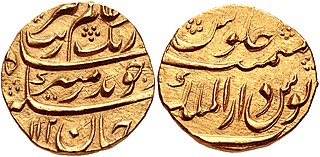
The economy of the Mughal Empire was very large and prosperous. The gross domestic product (GDP) of the Mughal Empire in 1600 was estimated at 22% of the world economy, the second largest in the world, behind only Ming China but larger than Europe. By 1700, the GDP of Mughal India had risen to 24% of the world economy, the largest in the world, larger than both Qing China and Western Europe. The Mughal empire was producing about 25% of the world's industrial output up until the 18th century. India's GDP growth increased under the Mughal Empire, with India's GDP having a faster growth rate during the Mughal era than in the 1,500 years prior to the Mughal era. Mughal India's economy has been described as a form of proto-industrialization, like that of 18th-century Western Europe prior to the Industrial Revolution.
References
Citations
- ↑ Eaton (1996), pp. 145–148
- ↑ "Bara-Bhuiyans, the - Banglapedia".
- ↑ Eaton (1996), p. 150
- ↑ Eaton (1996), p. 194
- ↑ Eaton (1996), pp. 155–156
Sources
- Eaton, Richard Maxwell (1996), The Rise of Islam and the Bengal Frontier, 1204-1760, University of California Press, pp. 145–148, ISBN 978-0-52020-507-9